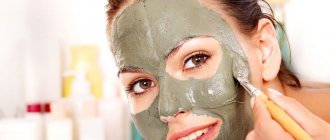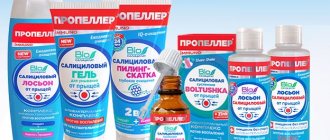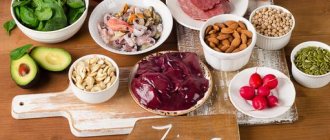Indications and contraindications
Before carrying out cosmetic procedures at home, you should be sure to familiarize yourself with the contraindications to them. Sometimes, if the products are used incorrectly, the skin begins to become even more covered with acne, and the woman abandons her care, believing that all homemade masks work this way. But this is the wrong approach.
Indications for using homemade masks
A dermatologist will be able to most correctly assess the condition of the skin, since he is a specialist in his field.
If visiting a cosmetologist is impossible for some reason, you should try to do it yourself.
Masks will be beneficial if:
- an oily sheen appears on the epidermis an hour after washing;
- black spots, inflamed comedones, pimples are observed on the face;
- the skin is oily, but due to aggressive drying, peeling began to appear;
- allergies are observed when using purchased cosmetics;
- use them for prevention, without waiting for problems to appear.
It is necessary to remember that the sooner the epidermis begins to receive proper nutrition, the less likely it is that warning signs in the form of acne will begin to appear. Therefore, prevention is the best way to fight.
Contraindications
The use of masks in the presence of contraindications risks the fact that, at best, there will be no effect, and time will be wasted. At worst, you may experience more acne, dry skin, or allergic reactions.
No masks should be used if:
- there are open wounds on the face after squeezing out pimples, abrasions;
- the skin is more than 30% covered with purulent rashes;
- the patient has skin cancer, eczema and other serious diseases;
- there is a tendency to allergic reactions (in this case, you should initially undergo an allergy test);
- after 2 weeks of use there is no improvement or the number of acne has increased.
If there are any contraindications, you should consult a doctor about the effectiveness of homemade masks. Sometimes the rashes are bacteriological in nature and you cannot do without special creams with an antibiotic.
Efficiency and result
With oily problem skin type, a lot of sebum is secreted, so the pores expand and rashes appear. Clay masks will clean pores, tighten them and regulate the production of skin secretions . With regular care of clay masks, pimples and roughness on the skin will disappear. After using the above types of clay for problem skin, your face becomes fresh. The skin will be cleansed of impurities and toxins. Thanks to clean pores, the skin begins to breathe and reacts to creams completely differently. The hydrobalance of dehydrated skin is normalized.
Thanks to the correct application and use of masks, combination skin will not become dry on the cheeks, and the T-zone will get rid of oily shine and redness.
Dry, thin skin also often has irritation and an unpleasant feeling of tightness. With the help of clay, you can easily get rid of such problems and maintain a feeling of lightness and moisture for a long time.
Sluggish mature skin will become elastic, tightened, and elasticity will be restored. The contours of your face will be clearer than before clay treatments. The skin will be saturated with beneficial microelements, and the water balance will improve. Skin cells normalize their work.
General cooking rules
In order for a mask for problematic facial skin not only to lie on its surface, but also to work, you should follow the rules for preparing and storing such products. This will help you not waste time and see results after a couple of weeks.
- Hands must be washed thoroughly before preparing. The same should be done with those products that will be included in the composition (of course, if it is not honey or powder form).
- You should allocate special dishes for preparing the mask in which food products will not be stored.
- All ingredients must be fresh, have a good shelf life, natural and, if possible, homemade.
- The mask should not be stored in the refrigerator for more than two days. Since the procedure should be carried out twice a week, it is better to prepare a new portion of the product each time, designed for one use.
- You should adhere to the specified quantities of all ingredients, and try not to cook by eye.
Its effect on the skin depends on how the mask is prepared. Violation of the rules can lead to the spread of infection throughout the face with the appearance of new pimples, or no effect at all.
Features of problem skin
Problem skin is characterized by redness, pimples, and enlarged pores. Often such skin has an unhealthy color and constantly flakes off. For all people, and for women in particular, problematic skin is a source of constant problems, not only cosmetic, but also psychological. Therefore, it is necessary to take care of such skin especially carefully.
The main task of daily care for problem skin is the timely and thorough removal of excess dirt and fat, as they cause blockage and inflammation of the pores. The most problematic areas are the forehead, nose and cheeks.
Actually, it is the abundance of sebaceous secretions that determines the features of caring for problem skin, since such oily deposits simply cannot be removed with regular washing with water. By the way, using hot water also does not solve the problem, and sometimes aggravates it, as it promotes even more abundant sebum secretion, and even expands the pores. But, according to reviews, masks for problem skin help to cope with this problem well.
Recipes for popular masks for problem skin
There are many recipes for masks that promise miraculous results after the first use. You shouldn't believe this.
Natural ingredients act gently and carefully, so it is impossible to achieve smooth skin in one day. Only with regular use will the results be noticeable.
At the first signs of improvement, you should not stop home treatments; it is enough to halve their number and carry them out once a week.
Yeast
This mask is used to normalize lipid metabolism, ensure good functioning of the sebaceous glands and prevent the appearance of the first signs of aging.
The fungi found in yeast contain many of the following:
- vitamins,
- antioxidants,
- phospholipids, which have a beneficial effect on the condition of cells.
Yeast is added to many store-bought creams because of its beneficial effects. The inexpensive component allows you to reduce the cost of the product, and also finds successful use in the preparation of home care products.
Suitable for:
- oily and problematic skin prone to rashes;
- dry, with the first signs of wrinkles.
The yeast mask mattifies the epidermis without drying it out. This component is most effective if you combine external remedies with the use of yeast internally in tablet form.
Preparation
To prepare a yeast mask, you should take:
- 3 tablets of pressed yeast or 15-20 g. finished powder;
- a tablespoon of white clay;
- a teaspoon of lemon juice (if allergies are present, this component should be removed).
Mix all ingredients until a homogeneous paste is obtained. If necessary, you can add more water. Apply on face for 15 minutes, then rinse. Use twice a week. The course lasts 2-3 months.
From gelatin
Gelatin masks are excellent substitutes for collagen products. They help get rid of imperfections on the skin and slightly mattify it. A pleasant bonus is a slight lifting effect.
With gelatin you can:
- smooth out the epidermis,
- even out complexion
- rid the skin of dead particles.
The result is noticeable after the first procedure, but for full impact you need to complete the course.
Preparation
To make a gelatin mask you will need to prepare:
- a tablespoon of gelatin;
- 5 tablespoons of milk or water.
Pour the liquid over the gelatin and leave until the ingredient swells slightly. After this, it is necessary to heat the composition in a water bath to room temperature and apply immediately.
With regular use, the skin becomes clearer, acne goes away, and the first wrinkles are smoothed out.
Oatmeal
An oatmeal face mask is perfect for problem skin. The cost of this product is three kopecks, and the result exceeds all expectations. This happens due to the viscosity of the pulp, which dries on the face, slightly tightening the skin.
After use:
- pores are noticeably narrowed,
- healthy and even complexion,
- The shine doesn't bother me for a long time.
If no cosmetic product helps, you should definitely try an oatmeal mask.
Preparation
To prepare you will need:
- a tablespoon of oatmeal;
- three tablespoons of water or milk;
- 4-5 crushed aspirin tablets (if inflammation is present).
Before cooking, rinse the cereal thoroughly. Then fill it with warm milk or water. Add aspirin. Apply the resulting pulp in a thick layer to your face. Leave until completely dry, then rinse.
Find out if mesotherapy is effective for post-acne.
How to get rid of post-acne? The answer is here.
Kefir
Kefir does an excellent job of cleansing the skin, reducing the pigmentation of freckles and post-acne, whitening them. Fights acne, significantly reducing their number.
Vitamin pyridoxine, found in dairy products, is used in many products that care for problem skin.
If you don’t have time for home treatments, you can regularly wipe your face with kefir, and the results will also not be long in coming.
Preparation
For the mask you should prepare:
- 50-100 gr. kefir;
- 1 tablespoon of white clay.
Mix the ingredients until smooth, then immediately apply to the face. You should use it regularly, otherwise there will be no noticeable results.
If there are blackheads present in any face masks, it is better to add white clay. Black can clog pores even more, although it also successfully fights inflammation and oily shine.
Alginate mask
This product is obtained from alginic acid, which is found in brown algae. The mask can be bought at the pharmacy in the form of a ready-made powder, which just needs to be diluted with water and applied to the face.
Sometimes blue clay is added to the composition, which helps enhance the effect of smoothed skin, fights rashes and other imperfections of the problematic epidermis.
It is better to use an alginate mask in a salon due to some complexity in its preparation. But you can learn this skill at home.
It is necessary to carefully study the instructions on the packaging and use the components in exact proportions. The result from the application is no worse than the salon one.
How to order flowers for delivery?
Recipes for vitamin masks for problematic facial skin types One of the mandatory procedures in maintaining the health of your skin is face masks . Masks for problem skin should act delicately, and their first rule is to do no harm! Care for problem skin types should be gentle and gentle.
Problematic facial skin types include flaky, acne-prone, porous, sensitive and irritable skin. There are recipes for vitamin masks that can be prepared from fruits and vegetables known to all of us . These masks will take proper care of your problematic skin. They will not only nourish the skin with vitamins, but also soothe irritated skin and cleanse dirty skin, giving it a healthy look.
Masks for flaky facial skin made from fruits and vegetables
Flaky facial skin
Flaky skin is the result of several reasons - external and internal. Internal disorders include disorders of the body, for example, allergies or metabolic disorders. In these cases, it is imperative to contact specialists.
External factors include external factors (frost, cold wind, scorching sun, dry indoor air, use of poor quality decorative cosmetics, etc.). Also, the skin peels off in those with dry skin type.
The following masks are suitable for this skin type:
Carrot mask for flaky skin
You will need:
- One fresh carrot (medium size);
- One chicken egg;
- One teaspoon of olive oil;
- Lemon or grape juice ½ teaspoon.
Making a mask:
- Grate the carrots on a fine grater;
- Separate the yolk from the white (you will only need the yolk);
- Stir the yolk with olive oil;
- Add any of the proposed juices;
- Mix all products with carrots;
- Apply the mask to the skin of the face;
- Keep for 20 to 25 minutes;
- Remove the mask with a cotton swab, which needs to be moistened in warm milk or warm water.
It is recommended to make this mask 1-2 times a week.
Cabbage mask for flaky skin
You will need:
- Fresh cabbage about 100 grams;
- White of one egg;
- Lemon juice one teaspoon;
- One teaspoon of honey.
Making a mask:
- Grind the cabbage to make a paste and squeeze out the juice;
- Beat the egg white thoroughly with a fork;
- Add lemon juice and honey to the protein;
- Mix everything with cabbage juice;
- Apply the resulting mask to your face;
- Hold for 10 minutes;
- Rinse with water (30-35°C), no higher;
- Finally, you need a cold compress.
Apple mask for flaky skin
You will need:
- One apple;
- One teaspoon of honey;
- Olive oil 5-6 drops.
Making a mask:
- The apple needs to be grated on a fine grater;
- Add honey and oil, stir;
- Apply the mask to the skin of the face;
- Keep for 20 to 25 minutes;
- Wash off the mask with lemon water (squeeze a few drops of lemon juice into warm water);
- Give your face a light massage.
Masks for acne-prone skin from vegetables and fruits
Acne facial skin
Acne skin is not a separate type of skin. This is a consequence of the characteristics of oily skin, hormonal changes in women and adolescents. The result of stress, poor nutrition and abuse of hormonal drugs, the use of fat-based cosmetics, as well as foundation creams that contribute to clogging of the sebaceous glands.
This kind of skin causes a lot of worries. Acne, pimples, and blackheads appear on the skin. When using masks for acne, apply them mainly to the T zone of the face (forehead, nose, chin).
Potato mask for acne skin
You will need:
- One potato tuber;
- Juice from one lemon;
- One tablespoon of almond oil;
- Calendula flowers (crushed) one tablespoon.
Making a mask:
- Potatoes must be boiled and crushed;
- Add lemon juice and almond oil to the potatoes and stir;
- Add calendula flowers;
- Apply the mask to your face;
- Keep for 10 to 15 minutes.
You can use the mask every other day.
Cabbage mask for acne skin
You will need:
- Fresh cabbage 100 grams;
- Lemon juice (from one lemon);
- Hydrogen peroxide solution (5%) one tablespoon;
- Viburnum juice one tablespoon.
Making a mask:
- Finely chop the cabbage;
- Make a mixture of lemon juice and hydrogen peroxide;
- Grind the cabbage in this mixture to make a paste;
- Add viburnum juice to the resulting slurry and stir;
- Apply the mask to your face for 10 minutes, but no more;
- Then rinse thoroughly.
The mask can be used twice a week, provided that your skin is not dry or irritated.
Watermelon mask for acne skin
You will need:
- You will need very little watermelon pulp;
- Olive oil one tablespoon;
- Two tablespoons of rowan juice;
- Any vitamin cream;
- Two egg yolks;
- Lemon juice one tablespoon.
Making a mask:
- The watermelon pulp needs to be thoroughly mashed;
- Separately mix olive oil, rowan juice and vitamin cream;
- Mix the resulting mixture with the yolks and grind thoroughly;
- Add watermelon pulp, stir;
- Just before applying the mask to your face, add lemon juice;
- Apply the mask to the skin of the face and neck;
- Cover with a linen napkin;
- Keep the mask on for 20 minutes;
- Remove thoroughly but gently using a cotton swab dipped in warm water.
Masks for porous facial skin made from vegetables and fruits
Porous facial skin
Porous skin , like acne, is also not a separate type of skin.
Porous skin is clearly expressed in oily and combination skin. In the second skin type, porous skin can be observed in the T zone (chin, nose and forehead).
The appearance of porous skin due to greatly enlarged pores is very similar to an orange peel. Looks rough, doughy and thick. Often such skin is covered with black dots.
For porous skin, masks made from the following vegetables are suitable:
Tomato mask for porous facial skin
You will need:
- Two ripe medium-sized tomatoes;
- One glass of boiling water;
- Two tablespoons of grape juice;
- One teaspoon of oil (olive);
- One tablespoon of potato starch.
Making a mask:
- Place the tomatoes in a bowl and pour boiling water over them;
- Keep the tomatoes in boiling water for about 2 minutes;
- Drain the water, cool slightly, remove the skin and pass through a fine sieve;
- Add grape juice, oil and starch to the tomato mass, stir;
- Apply the mask to your face;
- Keep for 20 minutes;
- Rinse off the mask with previously prepared salted water.
Watermelon mask for porous facial skin
You will need:
- Watermelon pulp;
- Pulp from grapes;
- One teaspoon of nut butter (walnut) or almond butter.
Making a mask:
- Remove the seeds and skins from the grapes;
- You need to take equal amounts of watermelon and grape pulp, i.e. 1:1;
- Make a puree from grapes and watermelon, mashing them and stirring;
- Add butter to the pulp;
- Apply the resulting mask to your face;
- Keep for 20 minutes;
- Rinse off with warm water;
- And just blot your face with a napkin.
Melon mask for porous facial skin
You will need:
- Melon pulp;
- Pulp from grapes;
- Lemon juice 4-5 tablespoons;
- A few drops of vegetable oil;
- Two tablespoons of oatmeal.
Making a mask:
- Remember a small amount of melon pulp;
- Free the pulp of several grapes from seeds and skins, remember;
- Mix melon and grape pulp;
- Mix lemon juice with vegetable oil;
- Add the mixture to the melon and grapes, stir;
- Add oat bran and stir. You should get a homogeneous mass;
- Apply the mask to your face and keep it on for 20 minutes;
- Rinse off with warm water;
- Blot with a soft cloth;
- Wait about five minutes and do a light massage.
Apple mask for porous skin
You will need:
- One large apple;
- Warm water ½ cup;
- Juice from one lemon;
- Two tablespoons of oatmeal.
Making a mask:
- Take warm water, add lemon juice and pour oatmeal into it, let it brew;
- At this time, peel the apple and grate it on a fine grater;
- Add the grated apple to the soaked flakes and mix;
- Apply the finished mask to the face;
- Hold for 15 minutes;
- Wash off with warm water;
- We do a light massage.
Masks for sensitive skin made from vegetables and fruits
Sensitive facial skin
Sensitive skin causes a lot of problems for its owners. The main signs of sensitive skin are redness, irritation, burning, itching, peeling. These symptoms can be caused by various factors.
The main reason is that the skin loses its protective barrier, which is disrupted by an impressive number of such factors: stress, some internal diseases (for example, vegetative-vascular dystonia, disruption of the gastrointestinal tract, etc.), improper or too aggressive skin care face (for example, peeling, various cosmetic injections, thermal procedures, etc.), the use of low-quality cosmetics, hormonal changes, poor nutrition, allergic reactions (determined individually), aggressive environmental influences (sun, wind, frost, temperature changes, high humidity , dry air, etc.), visiting a solarium (ultraviolet), when taking medications, as well as with a hereditary predisposition (naturally sensitive skin).
Sensitive skin requires the most gentle care, so when applying any cosmetics, test them first on a small area of skin. For sensitive skin we offer the following natural masks:
Cabbage mask for sensitive skin
You will need:
- Approximately 100 grams of fresh cabbage;
- Three tablespoons of fat cottage cheese;
- One tablespoon of squeezed lemon juice;
- One tablespoon of honey;
- One glass of warm boiled water.
Making a mask:
- Chop the cabbage very finely;
- Pour lemon juice into the cottage cheese, stir and grind thoroughly;
- Dissolve honey in warm boiled water;
- Mix all prepared ingredients thoroughly;
- Apply the finished mask to your face;
- Keep for 15 minutes;
- Rinse off the mask with water at room temperature;
- Massage with light finger movements.
Melon mask for sensitive skin
You will need:
- A couple of tablespoons of ripe melon pulp;
- Processed cream cheese (without additives) 100 grams;
- Liquid honey one teaspoon;
- Juice squeezed from one lemon;
- One glass of clean water.
Making a mask:
- Melon pulp should be crushed with a spoon or fork;
- Grate the processed cheese on a fine grater;
- Mix finely grated cheese with honey;
- Add the cheese mixture to the melon gruel;
- Stir lemon juice into a glass of water;
- Pour lemon water into the cheese and melon mixture;
- Mix thoroughly, stir until smooth;
- Apply the mask to your face;
- Keep the mask on for 25 to 30 minutes;
- Soak a gauze swab in warm milk and remove the mask with it;
- Rinse your face with water at room temperature;
- Pat your skin dry with a soft cloth.
Apple mask for sensitive skin
You will need:
- One large ripe apple;
- Fat sour cream or cream one tablespoon;
- 5-6 drops of olive oil.
Making a mask:
- Peel the apple and remove seeds;
- Cut into thin slices;
- Boil water, salt it and place our apple slices in boiling water for 2-3 minutes;
- Remove the slices from the water and crush them into a paste;
- Add full-fat sour cream or cream to the apple pulp, mix well;
- Add olive oil, stir;
- Now the finished mask can be applied to the skin of the face;
- Keep the mask on for 20 to 25 minutes;
- The mask will need to be washed off with warm water;
- Use a soft cloth to blot your face;
- After washing off the mask, do a light facial massage after 5 minutes.
Masks for irritable facial skin made from vegetables and fruits
Irritable facial skin
Irritable facial is usually the result of external factors. Rashes and redness may appear on the face. Just like with sensitive skin, there are a lot of such factors, and most often they are repeated.
These factors include: hormonal changes, menopause, menstrual periods; allergic reactions to foods, cosmetics, household chemicals, pollen, dust, wool and other allergens; insufficient facial care, namely improper cleansing of the facial skin; frequent contact of the skin of the face and hands, especially unwashed ones, or rubbing the skin on the face with hands; poor nutrition; low-quality cosmetics; synthetic clothing; washing the face with soap; external negative environmental impact, etc.
Each body responds to stimuli differently and individually. For some, the negative factor does not cause any complications, but for others it manifests itself in the form of irritation. It is important to find the reason. If you have such a problem, then we offer you the following masks that are suitable for irritable skin on the face.
Carrot mask for irritable facial skin
You will need:
- One large juicy carrot;
- Honey two tablespoons;
- Two tablespoons of freshly squeezed grape juice;
- Two tablespoons of freshly squeezed red currant juice.
Making a mask:
- Peeled and thoroughly washed carrots should be grated on a coarse grater;
- Add honey to the grated carrots and stir;
- Mix the juices and pour them into the carrots and honey;
- Mix the mask thoroughly;
- Apply it to your face;
- Keep for 10 to 15 minutes (no longer);
- The mask should be washed off with warm water and blotted with a soft cloth;
- Then place a dry linen cloth on your face and hold it for about 5 minutes;
- Next, do a light facial massage.
Apple mask for irritable facial skin
You will need:
- One apple is ripe and juicy;
- Oatmeal flakes two tablespoons;
- One tablespoon of freshly squeezed viburnum juice;
- One tablespoon of freshly squeezed red currant juice.
Making a mask:
- Peel the apple and grate it on a fine grater;
- Prepare warm water and pour it over the oatmeal. You will need just enough water to hide the flakes;
- Infuse the flakes for 5 minutes;
- Mix grated apple and swollen oat flakes, stir;
- Mix the juices and add them to the apple-oat mixture, mix everything;
- Leave the mask to sit for 5-10 minutes;
- Apply the mask to your face and keep it on for 10 to 15 minutes;
- Rinse off the apple mask with warm water;
- Dry your face with a soft cloth.
Pear mask for irritable facial skin
You will need:
- One ripe large pear;
- Two tablespoons of freshly squeezed carrot juice;
- One tablespoon of freshly squeezed grape juice;
- One teaspoon of potato starch.
Making a mask:
- Remove skin and seeds from the pear;
- Grate it on a fine grater;
- Pour both juices into the grated pear and stir;
- Add starch to the resulting mixture and stir;
- Now the mixture with starch needs to be slightly heated;
- Apply a warm mask to your face for 20-25 minutes;
- After the time has passed, remove the mask with a soft cloth;
- Rinse your face with water.
If you feel discomfort without rinsing your face, then after some time, rinse it with warm water.
Try our recipes and let them help you become charming.
Take care of yourself and always be beautiful! Excellent(1)Bad(0)
How to apply and wash off
50% of the success of the entire procedure depends on how the product is applied to the skin. The components simply will not work if the epidermis is not prepared for application of the product.
What needs to be done before the moisturizing procedure?
- Clean your face thoroughly and use a scrub. This procedure will help remove excess fat and dead cells that prevent the penetration of active substances into the deep layers of the epidermis.
- It is advisable to steam your face. This stage will open the pores and also help the mask penetrate deeper into the skin.
- Apply the mask with clean hands or a brush, not in a very thick layer, unless required by a specific recipe.
- The care product should be washed off under running water, without using soap. If one of the components of the mask is oil, you can use a special washing gel that will help wash away the greasy film.
- After all procedures, the skin should be moisturized with cream or serum.
If you ignore all the preparatory stages, applying a caring mask simply does not make sense. It will not be able to penetrate inside, will settle on the surface and will not have any positive effect.
Read how to choose a facial toner for problem skin.
What should be the makeup base for problem skin? Review here.
What are the causes of dry skin on the lower legs? Click go.
Clay masks - application
In order for clay masks to give 100% of their beneficial properties to the skin, you need to take a responsible approach to their preparation and skin preparation .
Skin preparation
- It is very important not to do any traumatic procedures to the skin at least a week before the mask. This applies to chemical and fruit peels, as well as mechanical facial cleansing.
- On the day of applying the mask, you can make a light scrub. But this is not necessary, since the clay itself is partly an exfoliant. And if the mask contains scrubbing components, such as semolina or oatmeal, then a scrub is not needed at all.
- When all the ingredients for preparing the mask are on the table, you can safely go and wash your face with warm water. We wash ourselves with our usual cosmetics. After this, it is advisable to steam the skin, especially if it is oily with clogged pores. Now the active microelements of clay masks will easily penetrate the layers of problem skin.
- Women with problem skin should not wash their face with hot water. Hot water promotes even greater secretion of skin secretions.
- We don’t use toner after washing.
- We don’t wipe, but blot our face with a towel.
- The skin is ready for the mask.
Masks will not bring the desired result if they are made without following such simple but very important rules.
Applying a mask and other important processes
- Apply the mask with a cotton pad, ceramic or glass special spatula. You can use brushes; it makes no difference what the bristles should be, artificial or natural.
- The density of the mask directly depends on your skin type. Dry, irritated skin needs a thin layer. And for oily skin it is better to apply two or even three layers. We apply more mask to the T-zone, where the skin is porous, and you don’t need as much on dry cheeks.
- We also use the mask depending on your skin type. For dry skin, five minutes is enough the first time, ten minutes from the second time. And for oily and combination skin, it is useful to keep the mask on for longer – 15-25 minutes.
- Wash off the mask with plain water or herbal infusion. It is possible to remove the mask with a damp cotton pad, but this is not comfortable.
- Women with dry skin must moisturize it after the mask. But for other skin types this is not necessary.
- If there is a mask with a large amount of oils left, it can be stored in the refrigerator for 3 days, but no more. Essential oils as natural preservatives will preserve the healing properties of clay. But a clay mask without esters will lose its beneficial substances and dry out. In any case, do not be lazy and prepare the mask before applying.
- We make masks no more than twice a week, otherwise the situation with problematic skin will only get worse. The more often such procedures are performed, the more sebum is released.
Tips from cosmetologists
Cosmetologists all over the world are trying to convey to girls a number of unspoken rules that will help those with problem skin look attractive.
There is nothing complicated about them, and, if desired, every female representative will be able to remember them.
- You should not touch your face with dirty hands, outerwear, or go to bed on stale pillowcases.
- Do not overdry problem skin with aggressive acne products. If there are any, it is better to apply the alcohol composition pointwise to the problem area.
- Even oily skin needs to be thoroughly moisturized. This will help prevent the epidermis from secreting excess oil to protect itself.
- Avoid direct sunlight on your face, protect it from cold wind, rain, and snow.
- It is worth regularly using masks, scrubs, and exfoliating peels with acids. After these procedures, the epidermis also needs to be thoroughly moisturized.
- Do not use expired decorative cosmetics, avoid using foundation every day.
If you do not provoke problematic skin to secrete excess oil, moisturizing and nourishing it, then perhaps it will no longer be problematic. Regular care will eliminate imperfections and help the owner gain self-confidence. At worst, there are always cosmetologists who in our time are able to solve any problems with the epidermis.
Natural Moisturizers
Many women use store-bought moisturizing masks. They help moisturize the skin, but most of them provide only a temporary effect. And the price for such masks is usually quite high.
In addition, you can never be sure of the composition of a purchased mask. Most of them are made from unnatural and sometimes even harmful components for the skin.
Natural moisturizing ingredients are much healthier for the skin. These include:
- Water is the main moisturizing component for the skin. It is useful to use mineral or herbal water to cleanse the skin.
- vegetable oils are not only an excellent moisturizer, but also a nourishing and tonic agent. They contain vitamins of all groups, beneficial microelements and fatty acids. Vegetable oils will help remove fine wrinkles, improve complexion, and restore skin moisture balance. You can use avocado oil, olive oil, peach oil, almond oil, and coconut oil in moisturizing masks.
- honey – penetrates deep into the skin, nourishes and retains moisture. In addition, it has a lot of other beneficial properties for the skin.
- dairy products - well moisturize, nourish and tone the skin. They contain valuable microelements and vitamins.
- fruits, vegetables, berries - will help not only moisturize, but also saturate the skin with useful elements.
Photo: Before and after
Homemade moisturizing mask recipes
Moisturizing masks for oily skin are prepared using simple recipes at home. Depending on your goals, they can be nourishing, cleansing and help fight visible defects.
Before preparing the product, it is recommended to make sure that there are no individual intolerances to the components of its composition. To do this, you can test the mask on a small area of skin and track the reaction.
The main purpose of moisturizing masks is to saturate the skin with water. But why does our skin need moisture? There are several reasons:
- Together with water, the skin also receives a charge of oxygen, which is so necessary for proper nutrition of cells.
- Water cleanses our skin, helps remove all harmful impurities and toxins accumulated in its upper layers.
- According to modern cosmetologists, water is an excellent anti-aging remedy. It gives the skin youthfulness, improves complexion and gives the skin a special glow.
- With constant use, moisturizing masks can actively combat facial peeling. This is especially true in winter, when dry skin causes a lot of problems.
- The strong hydration that a good mask gives to the skin prevents the feeling of tightness and gives you a feeling of absolute comfort.
- Many of the moisturizing masks (for example, homemade masks made from fresh vegetables and fruits) saturate the skin not only with moisture, but also with vitamins. With a lack of vitamins, our skin, like the entire body as a whole, begins to experience vitamin deficiency, which manifests itself in constant pimples, redness and other imperfections. Regular use of vitamin moisturizing masks can effectively combat this phenomenon.
As you can see, moisturizing masks bring a lot of benefits. However, it should be remembered that a positive result is possible only with constant and rather long-term use. Experts advise applying such masks at least 2-3 times a week, and to achieve a special effect, you should continue the course of such therapy for at least three to four months.
Currently, there are several hundred simple and affordable mask recipes for moisturizing the skin. Many of them have existed for many centuries.
At all times, women wanted to look good, so they came up with new beauty secrets based on the products that they had at hand.
Passed down from generation to generation, many of these recipes have survived to this day and are still relevant and in demand today.
Tomato mask
This is an excellent moisturizer for problem skin. Such a mask will not only fill every cell with healing moisture, but will also draw out toxins and impurities from the skin.
Take one or two ripe tomatoes, peel them and rub the pulp and seeds through a sieve to obtain a puree (you can also use a blender).
Also add one teaspoon of potato starch and a few drops of any vegetable oil. Gently apply the resulting thick and viscous mixture to the skin. Exposure time is about twenty minutes.
Curd mask
Few people know, but ordinary cottage cheese is an excellent moisturizer, which, in addition, also perfectly nourishes the skin and gives it a fresh and well-groomed appearance.
Take cottage cheese with a fairly high fat content (at least nine percent). You will need 50 g of cottage cheese. Add to it a few tablespoons of milk, the same amount of fresh carrot juice and one teaspoon of vegetable oil (olive, corn, sunflower or any other to your taste). Thoroughly grind this mixture until smooth. Apply a thick layer to your face.
Leave the mask on for 12-15 minutes, then carefully remove. After completing this procedure, it will be useful to wipe your face with ice cubes made from plain water or some herbal decoction.
Honey mask
This is one of the oldest recipes, which was used by women in Rus' many centuries ago.
Take a tablespoon of honey, a tablespoon of vegetable oil and one yolk. Handle all components carefully. After this, put the mixture on the fire and heat slightly.
It is important that the mask is warm enough, but not hot - this will activate the hydration process and help maximize all the beneficial qualities of honey. Divide the warm mixture into two parts.
Apply the first half to your face and leave on for ten minutes. Then apply the rest of the mask to your skin and wait another ten minutes.
Cucumber mask
This recipe has excellent moisturizing properties due to the fact that most of the cucumber consists of water, in addition, this product can effectively whiten the skin and fight oily shine.
Take a medium-sized cucumber, grate it and apply the resulting pulp onto the skin. Exposure time is 12-15 minutes.
Carrot mask
Take a small fresh carrot, grate it, add a couple of drops of lemon juice, an egg yolk and one teaspoon of olive oil. Distribute the resulting paste evenly over your entire face.
To obtain the optimal effect, this mask must be left on for quite a long time - about half an hour.
Oatmeal mask
Take 30 g of oatmeal, pour 100 ml of warm milk or cream. If you have dry skin, it is better to choose cream, and with a fairly high percentage of fat content.
If your skin is of a combination type, you should prefer low-fat milk. Apply the resulting warm thick mixture to your face and wait ten minutes.
Carrot-apple face mask
Take fresh apple and carrots in equal proportions. Grate on a medium grater, stir thoroughly and apply to your face. Exposure time is at least ten minutes.
As you can see, all the above recipes are quite simple to implement and economical. They will not require you to buy expensive products, and you will probably find all the components of these masks at home.
However, each of these moisturizer options is very effective and allows you to fill your skin with moisture and give it a boost of energy and freshness. In addition, all these recipes are perfect for problem skin and will help you get rid of redness, pimples, oily sheen and other imperfections.
In order to maintain beauty, you do not need to spend fabulous sums on salon treatments. You can easily make useful moisturizing masks at home.
The main thing is not to forget that a positive result is possible only with regular use.
Before applying a moisturizing mask to the skin, you must first prepare your face for this cosmetic procedure. To avoid getting your hair dirty and to keep it out of the way, you need to pin it up and put on a bandage.
It is necessary not only to clean the skin, but also to wipe it dry. Makeup must be removed. Then you need to wash your face and perform a light exfoliation using a scrub, which effectively cleanses the skin, and the beneficial substances from the mask will be absorbed much better.
To protect the delicate skin of the eyelids, it is recommended to use a special cream designed to care for this area. It is important to remember that no moisturizing mask should be applied to the skin under the eyes and eyelids.
If the mask turns out to be too thick, it must be applied immediately. Some moisturizing masks must be liquid; in this case, you need to soak a clean napkin in it and apply it to your face.
Almost all moisturizing masks prepared at home are left on the skin for 20 minutes, after which they are washed off with warm water. If the product contains vegetable oil, for washing you need to use water whose temperature is not lower than 25? C.
To prevent such masks from causing allergies, first apply a small amount of the product to the inside of the arm and leave for a few minutes. If redness, rash, burning or irritation appears, it is better to discard it. If there are no negative consequences, the mask can be safely used.
Unlike ready-made purchased masks, home remedies have a completely natural composition, so they bring much more benefits. You can also select the ingredients yourself depending on your skin type.
Moisturizing anti-aging mask for normal skin
To prepare such a mask, take 200 g of water and bring it to a boil, then pour it into a glass container and add 3 tbsp. l. dried chamomile flowers. Then the container is tightly closed with a lid and left for a while until the broth is well infused.
After about 25–30 minutes, the broth needs to be filtered, after which 1 tsp is added. vegetable oil. In the finished mask, a clean napkin is moistened and applied to the face. After 20 minutes, you need to wash your face with warm water.
To achieve a lasting effect, this cosmetic procedure must be performed at least once a week.
Moisturizing and refreshing mask for dehydrated and dry skin
First you need to prepare a decoction of linden leaves (both fresh and dry raw materials can be used), then leave for a while until it cools well and filter.
1 tbsp is diluted in the decoction. l. oatmeal (you can grind oatmeal in a coffee grinder), then add just a few drops of vegetable oil. The resulting composition is applied to previously cleansed facial skin. After 25 minutes, you need to wash with warm water. This mask must be done every other day until the desired result is obtained, and then as a preventive measure.
Moisturizing and brightening mask for problematic and dry skin
Mix a few tablespoons of cottage cheese and 2 tbsp. l. milk. Then the composition is slightly heated and thoroughly mixed until a mass of homogeneous consistency is obtained.











